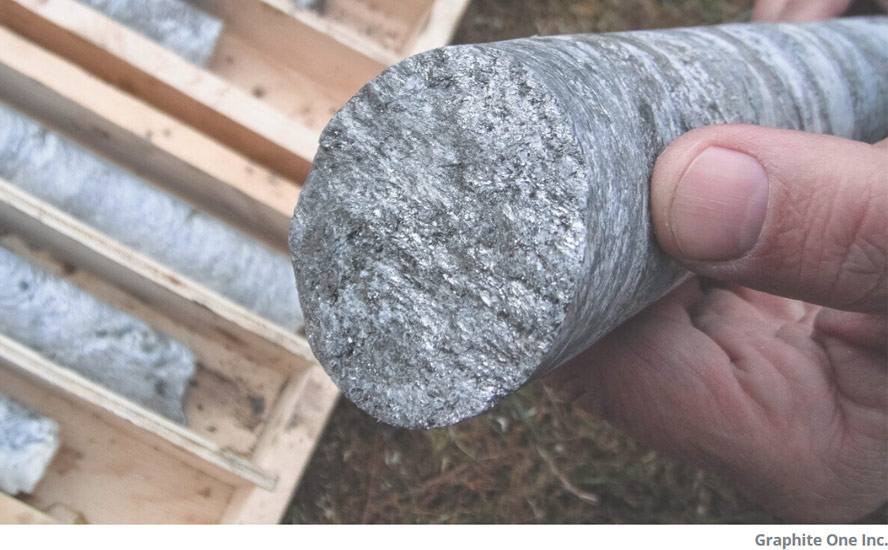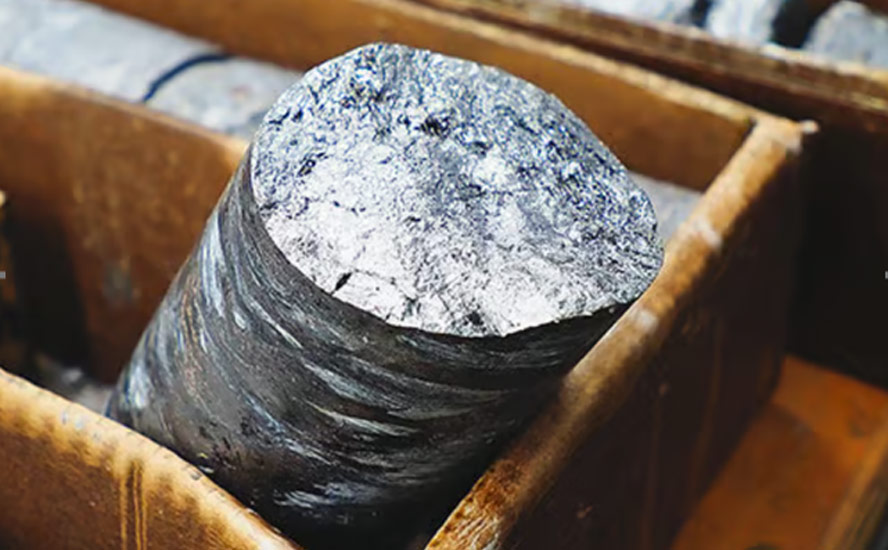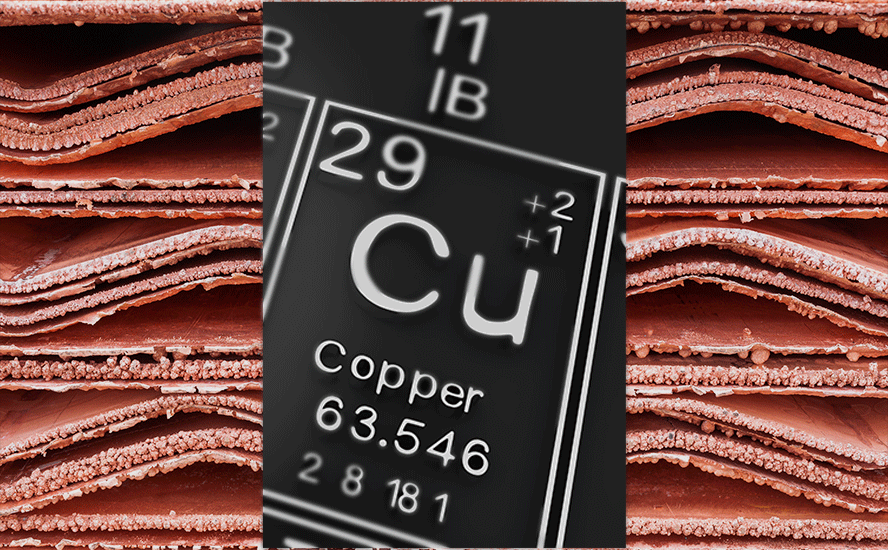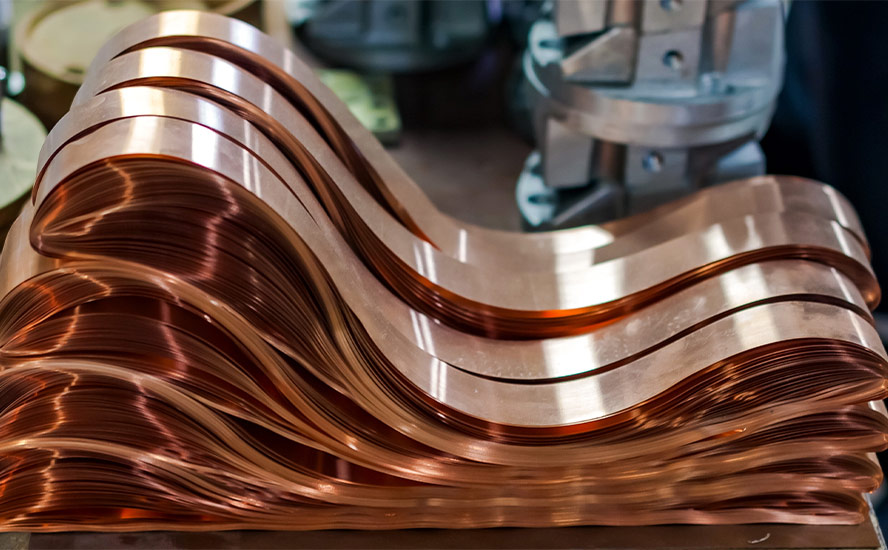GSP continues to explore past-producing Alwin Mine, as copper price support remains solid
2022.01.22
Copper has been one of the biggest winners of the commodities complex since 2020.
Not only is the tawny-colored industrial metal an essential part of economic growth, it is also imperative to the global transition towards sustainable energy sources.
Because electric vehicle are copper intensive (in fact tdhey use 4x as much copper as a regular vehicle), demand for copper has risen at an unprecedented pace with no signs of slowing down.

Wind and solar energy systems have the highest copper content of all renewable energy technologies, making the metal even more important in achieving climate goals.
Driven by robust industrial demand, copper prices surged to an all-time high of $4.77/lb in May of 2021. Compared to its trough of $1.94/lb in early 2016, this represents a 150% rally within a span of five years.

A report by Goehring & Rozencwajg, which specializes in natural resource investments, points out that recommendations on copper investments have focused primarily on bullish demand trends; the supply side of the equation also must be factored in.
The primary concern lies in the inevitable depletion of existing copper mines — a problem that has been brewing for over a decade.
A dearth of new copper discoveries and capital spending on mine development in recent years means that once an existing mine becomes exhausted, its output may not be replaced in time to meet the growing demand.
Moreover, since 2000, most reserve additions have come from simply lowering the cut-off grade and mining lower-quality ore as prices moved higher (e.g. Chile’s Escondida copper deposit), a practice that may not be feasible for geological reasons in the upcoming cycle, as Goehring & Rozencwajg argues.


Although there will be new projects coming online around the globe (DRC, Panama and Mongolia), these will only offset depletion at other existing mines, leading to stagnant overall mine supply growth.
Acuity Knowledge Partners, formerly part of Moody’s Corp., is predicting a widening demand-supply gap that could reach as high as 8.2 million tonnes by 2030.
For this reason, exploration companies holding high-quality copper assets will appeal to investors.
GSP Resource Corp.
One copper junior to recently catch the attention of AOTH, is GSP Resource Corp. (TSXV:GSPR, FRA:0YD). Vancouver-based and British Columbia-focused, the company’s flagship is the Alwin Mine Project located 18 km from the town of Logan Lake. The past-producing mine is southwest of the New Afton and Ajax mines, and less than a kilometer away from the Highland Valley Mine.
GSP was formed in 2018 with the goal of finding copper-gold-silver assets in southwestern BC. Management prefers the area’s three-season climate to the Golden Triangle of northwestern BC, which gets a lot of snow and therefore has a limited exploration window, roughly May to October. The company has an option to acquire a 100% interest in the past-producing Alwin copper mine, located in BC’s Highland Valley copper camp.
Alwin Mine Project
The Alwin Mine Project is 18 km from the town of Logan Lake, southwest of the New Afton and Ajax mines, and less than a kilometer from the Highland Valley copper mine owned and operated by Teck Resource Corp.

Small-scale mining was conducted at the Alwin Mine in the early 1900s, with modern exploration and mining occurring in two periods, from 1967 to 1982 and from 2005 to 2008. In all about 36,000 meters of historical drilling has been completed.
The first copper occurrence discovered in the Highland Valley was the Ashcroft glory hole, an outcropping copper deposit that saw limited mining during the First World War, then lay dormant until the 1960s when it was explored on a larger scale.
From 1967 to 1970, 6,940m of surface diamond drilling in 81 holes was drilled along the main Alwin mineralized trend, and 5,860m of underground drilling in 119 holes was completed in 1,400m of mine workings.
In 1980, Dekalb Mining Corp. expanded the capacity of the mill to 700 tons per day and resumed mining of the Alwin trend. Total production was 155,000 tonnes grading 1.54% Cu. Mining was suspended in 1981 due to low copper prices. At the conclusion of mining, a trackless development decline was extended to a depth of 270m and 3,935m of drilling was completed in 76 underground holes. Dekalb calculated a resource of 390,000 tonnes grading an average of 2.5% Cu, after factoring for 25% dilution. No cut-off grade was reported.
This historical resource is not National Instrument 43-101-compliant and therefore GSP is not relying on it for accuracy; more drilling needs to be done to bring the resource up to modern reporting standards.
An important aspect of the GSP story, is the fact that previous underground operators were focused on the high-grade copper mineralization — a series of deep and narrow replacement deposits. At a 1.5% cut-off grade with copper being less then a dollar a pound, and getting as low as US$0.56, the mine was never considered from a bulk tonnage, open-pit perspective. Ironic, considering that is precisely what the Highland Valley has become known for, with five large pits developed over the past 60 years including Teck’s Highland Valley open-cast copper-molybdenum operation.
Developed to a depth of 300 meters, the Alwin Mine produced over 233,000 tonnes from five zones between 1916 and 1981. It milled 3,786 tonnes of copper, 2,729 kilograms (87,739 oz) of silver and 42.6 kg (1,369 oz) of gold.
Fast forward to today, when the economics of copper mining are completely different, with copper currently trading at $4.53 a pound compared to a ballpark average 68 cents during the 1960s and early 1980s. The much higher copper price now makes the lower-grade areas of the Alwin Mine project more interesting if they can be developed into an open-pit mine.
GSP management believes there is a low-grade halo of mineralization north and south of an east-west trending structure, that could be bulk-tonnage and open-pittable.
A lot of historical drilling has been done at the Alwin Mine, however most of it was underground with short, tightly-spaced holes targeting the high-grade material. Not much was drilled from surface around the edges of the mine.
GSP decided to investigate what would happen if they stepped back from the east-west trending structure the mine sits on, at first pointing the drill south to north.
Drilling in 2020 from the southern property boundary towards the mine, GSP hit numerous low-grade halo structures that proved to be in excess of the Highland Valley pit’s 0.28% CuEq mining head grade. A side note: the Alwin property is so close to Highland Valley that when you stand on it you can see, hear and feel the mining trucks rolling “next door”.
The best intercept from the 10-hole 2020 drill program returned 62 meters at 0.3% copper equivalent (CuEq), “with some very high grades of silver in the guts of the high-grade zone,” CEO Simon Dyakowski told me.
2021 exploration
GSP has completed its 2021 drill program and all indications point to a porphyry-style copper system similar to the mineralization found at Highland Valley.
Last fall, a three-hole program was designed to further test the bulk grade of the Alwin deposit and surrounding lower-grade rock with the drill holes collared from the north of the historical deposit. Assay results are expected in the first quarter.
According to GSP, most of the alteration and mineralization observed in the upper and lower portions in all deeper drill holes intersecting rock greater than 20 meters from the shell of the Alwin deposit have copper porphyry-style characteristics similar to that seen nearby in the Highland Valley camp.
Together with last summer’s drilling, GSP’s 2021 eight-hole program totaled 2,313 meters, testing the bulk-tonnage copper potential of unmined mineralization within and surrounding the historical Alwin Mine. (4,200 meters and 18 holes in the past two seasons)
Highlights included 3.5% copper, 2.4% gold and 39.6% silver over 6.4m (4.66% CuEq) and 2.71% CuEq over 35.5m.
Bulk tonnage grade highlights were 0.61% CuEq over 164.6m, 0.14% CuEq over 176.7m, and 0.21% CuEq over 229.7m including a higher-grade 0.28% CuEq over 158.5m and 0.48% CuEq over 79.3m.
Among other milestones achieved last year, GSP obtained an important five-year exploration permit, and completed a 3D digital model of the Alwin Mine’s workings and drill data.
The model includes all known underground workings, separated into drift and declines, raises, cement-filled, rock-filled and open stopes and the numerous unmined copper-silver and copper-gold mineralized portions of the 425-meter long by 275m-deep by 150m-wide zone.
The permit allows GSP to carry out exploration activities including drilling, trenching and IP lines, for five years.
Also in 2021, GSP optioned 60% of its its Olivine Mountain Project located southeast of Alwin and about 25 km northwest of the producing Copper Mountain mine, to Full Metal Minerals. Exploration programs will be operated by GSP until the option agreement is completed, including a sampling program that started in September with results pending.
To fund current and upcoming activities, the company closed a $455,000 oversubscribed financing back in August.
“Work at Alwin to date continues to support the reimagining of the Alwin Mine from a high-grade underground operation to a potential shallow, bulk tonnage open-pittable deposit model,” Dyakowski stated in the Jan. 19 news release.

So far GSP’s plan is working. Mineralization has been identified in deep (>300m) holes more than 20 meters from the mine, which appears to verify GSP’s geological model of a low-grade halo of mineralization north and south of the east-west trending structure.
“We’re starting to be able to envision a sizeable amount of material as bulk tonnage,” says Dyakowski.
But the really exciting part of the project concerns the type of mineralization GSP could be looking at.
During 2021 drilling a new mineralized zone was discovered from hole AM21-02, shown as a dotted red circle on the above map. Previous drilling didn’t go very deep, but hole 2 of the 2021 program was completed to a depth of 367m. Near the end of the hole, the rock was found to be increasing in alteration. From 338m to 351m, the exploration team intersected what GSP describes as “an intensely mesothermal to epithermal clay style altered shear hosting dilational quartz vein fragments hosting coarse-grained pyrite and chalcopyrite.”
In plain English? This is evidence of a porphyry. Dyakowski explains:
“We punched through a lot of pyrite right in the area of a geophysical anomaly so we think that might be the top of an unknown porphyry. That’s something we’re going to save for next spring when we have a whole season of deeper drilling, but one of the main theories on Alwin is it is a skarn replacement system that’s associated with a larger porphyry.”
A porphyry deposit is formed when a block of molten-rock magma cools. The cooling leads to a separation of dissolved metals into distinct zones, resulting in rich deposits of copper, molybdenum, gold, tin, zinc and lead.
Porphyry deposits are usually low-grade but large and bulk-mineable, economics of scale come into play making them attractive targets for mineral explorers. Porphyry orebodies typically contain between 0.4 and 1% copper, with smaller amounts of other metals such as gold, molybdenum and silver.
In Canada, British Columbia enjoys the lion’s share of porphyry copper/ gold mineralization. These deposits contain the largest resources of copper, significant molybdenum and 50% of the gold in the province. Examples include big copper-gold and copper-molybdenum porphyries, such as Red Chris and Highland Valley.
GSP believes the mineralization it is encountering is part of the Highland Valley hydrothermal system associated with the Highland Valley copper mine, which has been operating for 50-plus years. Owner Teck Resources is planning an expansion that would extend the mine life to 2040.
A word of caution. GSP doesn’t yet know whether, a/ If what was found in hole 2 means it has hit a porphyry. More drilling is required to bolster this case. And b/ If it is indeed a porphyry system, is it a porphyry unique to the Alwin mine, or is it an extension of Teck Resources’ next-door Highland Valley copper-moly porphyry? An interesting fact to note here is Teck Resources has a copper-moly porphyry, GSP has been assaying a lot of gold and silver, the highest grades drilled yet to date in the Valley.
We do know that Teck is planning on expanding its mine and that there is a network of roads and drill pads to the west of the pit edge, as shown on the map below.

We learned from a local media source that the company is planning on extending the mine life to 2040 from its original closure date of 2027. The company is looking to expand the footprint by 800 hectares and would build out the Highmont pits and waste rock dumps. Teck has reportedly applied for permits needed to expand the more than 50-year-old operation. If approved, there would be a projected 25% increase in production, with construction starting in the first quarter of 2023.
How does the expansion affect GSP? Well again, it depends on whether the potential porphyry is its own, or an extension of Highland Valley’s. If GSP ends up discovering a new porphyry next to Highland Valley’s deposit, it may open up the possibility of a partnership with Teck, which could use ore from the Alwin mine as mill feed for its own operation, maybe even expanding it beyond 2040.
Dyakowski says he’s confident “we’ve got more than enough space to develop our own open-pit deposit and potentially look at a block cave just on our ground, but it does beg the question what is just over the line to the south and to the east, given that they are planning to mine there.”
GSP has other options besides partnering with the Canadian mining major. Only 45 minutes drive away on a paved highway is Nicola Mining’s fully permitted mill which is open to contract milling. Another potential partner is New Gold, which operates the New Afton Mine to the northeast. Gold Mountain Mining, focused on re-opening the Elk Mine about 57 km from Merritt, has been trucking their ore to New Afton for processing, suggesting that GSP could do the same with its ore from Alwin.
“Alwin couldn’t be in a better location from a development perspective,” says Dyakowski, “it’s very much a brownfields development in all directions.”
2022 plans
This year at the Alwin Mine Project, GSP will focus on incorporating new drilling data into the geological model, and updated the Alwin Mine 3D model. Management is planning a substantial infill drill program to support a future resource estimate, as well as seeking additional exploration targets.
At Olivine Mountain, there will be a partner-funded project review and sampling program, including at Hop, a copper-gold porphyry target.
In its shareholder update, the company says it is continually evaluating new opportunities to add value, through acquiring and developing projects with a southwestern BC focus.
Conclusion
At AOTH we are very encouraged by what we are seeing from GSP at its Alwin Mine Project.
Alwin has always been thought of as a high-grade underground mine and for good reason. During it last phase of production, 1916 to 1981, copper was a fraction of the >$4.00 per pound it is worth today, making any low-grade material surrounding the mine un-economic. Times have changed and the low-grade halo that appears to be north and south of the mine might, at +$4 copper, be a stand alone bulk-mined open-pit.
Clearly that is GSP’s intention and the company, imo, appears to be well on its way to proving the model. Between 2020 and 2021 drilling, they have come up with what we consider to be a significant amount of mineralization.
The last three holes drilled in the fall are vectoring north-south toward the mine, rather than the previous south-north drilling. GSP describes most of the alteration and mineralization observed in the upper and lower portions of these holes as having “copper porphyry-style characteristics similar to that seen nearby in the Highland Valley camp.”
We are eager to see the assays — they are expected to be available in Q1 — and what GSP is planning next at Alwin, once they have boots back on the ground in the spring.
GSP Resource Corp.
TSXV:GSPR, FRA:0YD
Cdn$0.18, 2022.01.20
Shares Outstanding 20.2m
Market cap Cdn$3.6m
GSPR website
Richard (Rick) Mills
aheadoftheherd.com
subscribe to my free newsletter
Legal Notice / Disclaimer
Ahead of the Herd newsletter, aheadoftheherd.com, hereafter known as AOTH.
Please read the entire Disclaimer carefully before you use this website or read the newsletter. If you do not agree to all the AOTH/Richard Mills Disclaimer, do not access/read this website/newsletter/article, or any of its pages. By reading/using this AOTH/Richard Mills website/newsletter/article, and whether you actually read this Disclaimer, you are deemed to have accepted it.
Any AOTH/Richard Mills document is not, and should not be, construed as an offer to sell or the solicitation of an offer to purchase or subscribe for any investment.
AOTH/Richard Mills has based this document on information obtained from sources he believes to be reliable, but which has not been independently verified.
AOTH/Richard Mills makes no guarantee, representation or warranty and accepts no responsibility or liability as to its accuracy or completeness.
Expressions of opinion are those of AOTH/Richard Mills only and are subject to change without notice.
AOTH/Richard Mills assumes no warranty, liability or guarantee for the current relevance, correctness or completeness of any information provided within this Report and will not be held liable for the consequence of reliance upon any opinion or statement contained herein or any omission.
Furthermore, AOTH/Richard Mills assumes no liability for any direct or indirect loss or damage for lost profit, which you may incur as a result of the use and existence of the information provided within this AOTH/Richard Mills Report.
You agree that by reading AOTH/Richard Mills articles, you are acting at your OWN RISK. In no event should AOTH/Richard Mills liable for any direct or indirect trading losses caused by any information contained in AOTH/Richard Mills articles. Information in AOTH/Richard Mills articles is not an offer to sell or a solicitation of an offer to buy any security. AOTH/Richard Mills is not suggesting the transacting of any financial instruments.
Our publications are not a recommendation to buy or sell a security – no information posted on this site is to be considered investment advice or a recommendation to do anything involving finance or money aside from performing your own due diligence and consulting with your personal registered broker/financial advisor.
AOTH/Richard Mills recommends that before investing in any securities, you consult with a professional financial planner or advisor, and that you should conduct a complete and independent investigation before investing in any security after prudent consideration of all pertinent risks. Ahead of the Herd is not a registered broker, dealer, analyst, or advisor. We hold no investment licenses and may not sell, offer to sell, or offer to buy any security.
Richard does not own shares of GSP Resources (TSX.V:GSPR). GSPR is a paid advertiser on his site Ahead of the Herd
Legal Notice / Disclaimer
Ahead of the Herd newsletter, aheadoftheherd.com, hereafter known as AOTH.Please read the entire Disclaimer carefully before you use this website or read the newsletter. If you do not agree to all the AOTH/Richard Mills Disclaimer, do not access/read this website/newsletter/article, or any of its pages. By reading/using this AOTH/Richard Mills website/newsletter/article, and whether you actually read this Disclaimer, you are deemed to have accepted it.



























